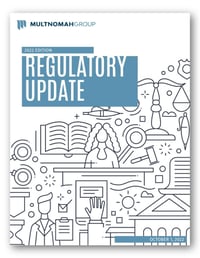Each year, our Technical Services Committee creates a Regulatory Update covering the legislative, regulatory, and litigation developments affecting retirement plans. This year on the legislative front, the House and Senate are reconciling bills focusing on retirement savings for a possible vote later this year. The expected provisions of the new bill are detailed in this blog.
Consolidation of Retirement-related Provisions
On March 29, 2022, the U.S. House of Representatives approved the bipartisan Securing a Strong Retirement Act by a vote of 414 to 5.
In June, the Senate Health, Education, Labor, and Pensions (HELP) Committee and several other committees with jurisdiction over retirement-related provisions approved a different version of Secure 2.0, the Rise & Shine Act, which had an additional 70 provisions that have yet to be put in legislative form.
This is expected to be combined with the Enhancing American Retirement Now (EARN) Act from the Senate Finance Committee. The goal is to reconcile the differences in the bills to form a new bill that may be signed into law later this year. If this does not happen, the entire legislative process will start over with a new proposal in Congress.
Listed below are several of the key provisions and their origin (Senate Bill or House Bill):
- Allow employers to automatically enroll workers into emergency savings accounts at 3% of pay with any excess contributions linked to a 401(k) account at the company. (Senate)
- Allow employees under the age of 59 ½ to withdraw up to $1,000 from their 401(k) or individual retirement account to cover emergency expenses without the 10% early withdrawal penalty tax. (Senate)
- Increase income cutoff and expand how people qualify for the saver's tax credit (House) and make the credit fully refundable where the refund would be required to be deposited into an employee's retirement account (Senate)
- Require employers who are establishing new plans to automatically enroll employees at a rate of at least 3% and then increase it each year until the worker is contributing 10% of pay. Workers could opt out at any time and would not apply to businesses with less than 10 employees and companies less than 3 years old. (House)
- Part-time employees that work between 500 and 999 hours for two consecutive years would be eligible to make voluntary contributions to their company's 401(k) plan. Employers would not be required to provide any matching contributions on voluntary contributions. (House & Senate)
- Increase the limit to allow employer force-outs of small sum balances for terminated employees from $5,000 to $7,000. (House and Senate)
- Allow employers to make contributions to a 401(k) plan on behalf of employees who are making student loan payments instead of contributing to their retirement account. (House and Senate)
- Require all catch-up contributions to be made on an after-tax basis. (House)
- Expand 401(k) catch-up for people between the ages of 62-64 to $10,000 for individuals and SIMPLE Plan catch-up to $5,000. (House and Senate)
- Gradually raise the required minimum distribution (RMD) age from 72 to 75. (House and Senate)
- Elimination of pre-death RMDs for Roth 401(k) accounts. (Senate)
- Allow employees to receive their 401(k)-matching contribution on a Roth basis (House and Senate)
 To read our full 2022 Regulatory Update, click the button below.
To read our full 2022 Regulatory Update, click the button below.


